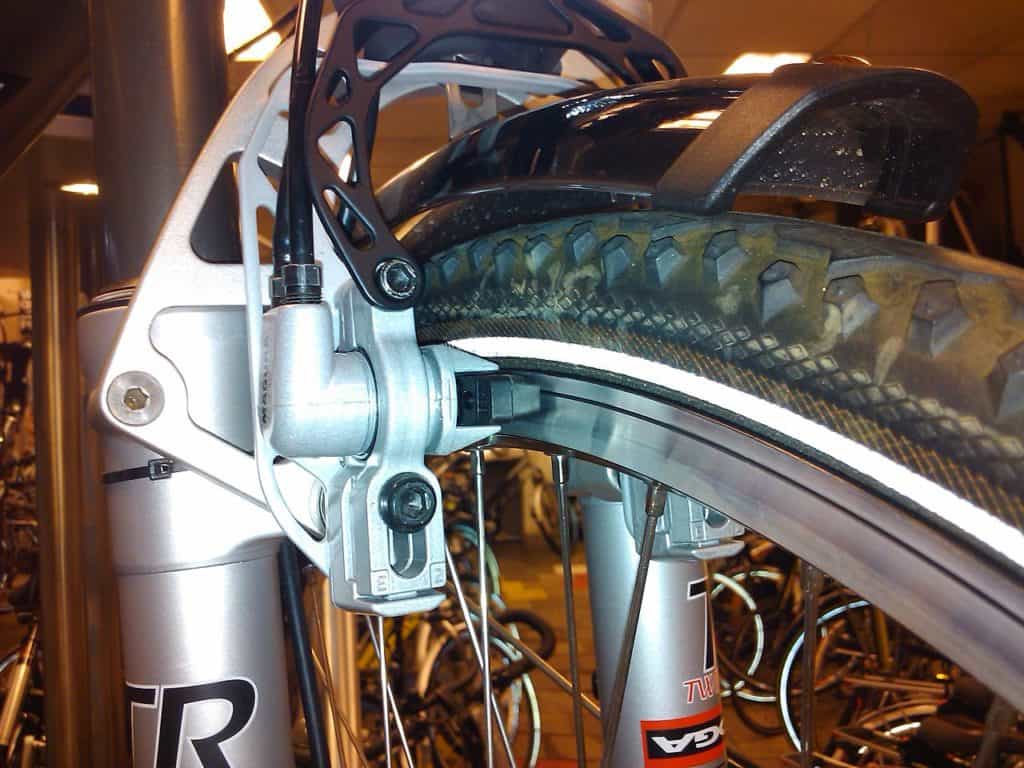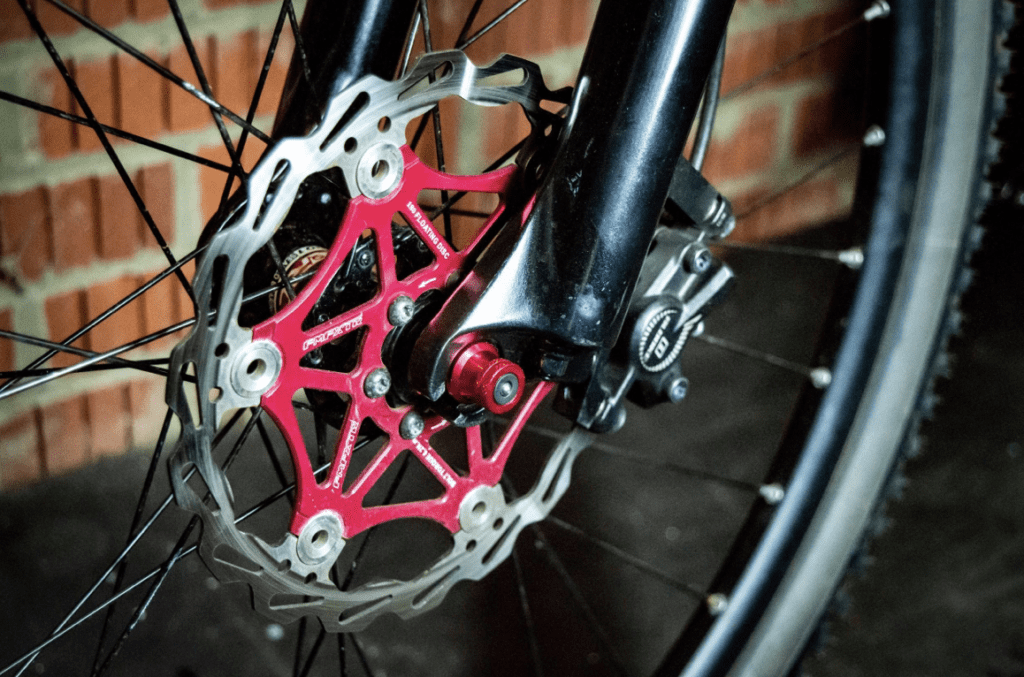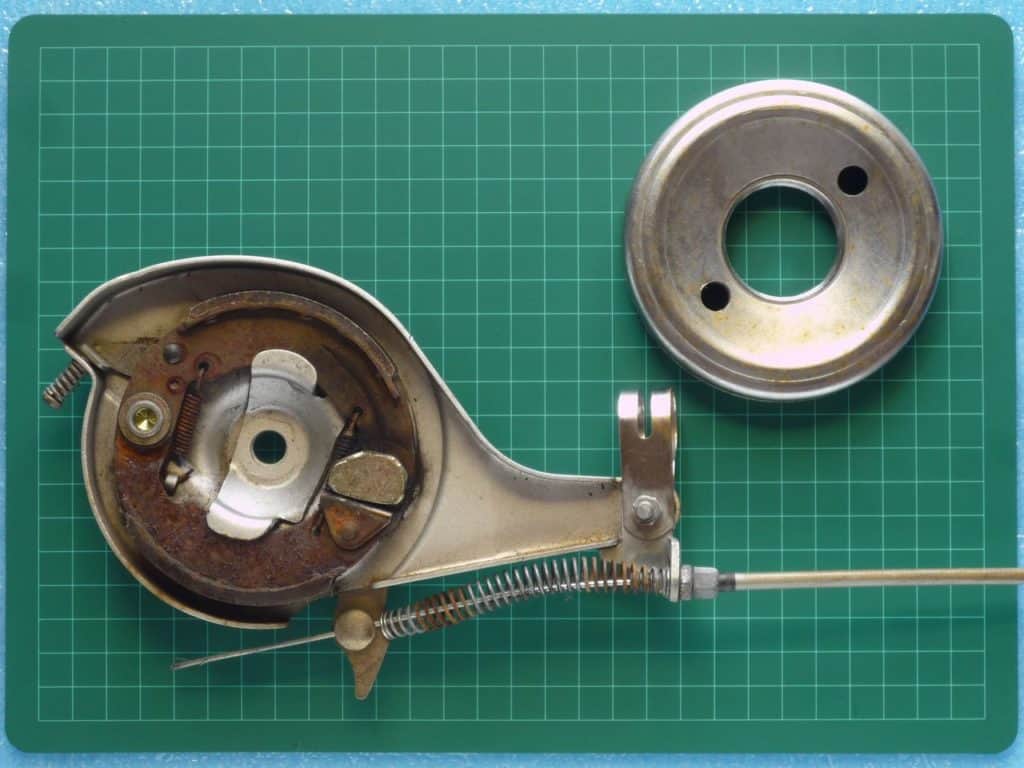Until adulthood, we always thought that bike brakes are nothing more than two levers attached to the handlebars that we have to squeeze to stop the bike, right? Well, there is more to that! After reading this guide about different types of bike brakes available on the market, you’ll easily know what type to choose according to your preferences.
So, whether you are a road or a mountain biker, give this article a thorough read and find out which type of brake is right for you. Let’s take a look, without any further ado:
Types of Bike Brakes and Their Functions Explained
Spoon Brakes

Popular in the 1880s, spoon brakes were the first brake type used when bicycles were introduced. Connected to the penny-farthings of the old-school bike, this type of brake had a large lever attached to the right side of the handlebar.
Other than that, it consisted of a leather pad. This was attached to the front tire. The lever and pad were connected through a rod that transferred the stopping power to help the pads press against the tire.
Even though spoon brakes have become rare now, they were still being used up until the 1930s in the whole of Europe. The stopping power wasn’t great but that’s what was being used mostly by our ancestors back in the day.
Duck Brake
After the bicycles started getting the spotlight, bike engineers focused on improving the quality of the brakes and this is where we get the duck brakes.
Introduced into bicycles in 1897, these brakes consisted of two levers, a rod, and two friction rollers usually made up of wood or rubber. Levers and friction rollers were connected through the rod and the rollers were attached to the front tire of the bike.
Properly set at an angle conforming to the shape of the tire and being mounted on the axle washers, duck brakes were able to stop the bike conveniently. The rollers squeezed the upper part of the tire thus forcing it to stop.
Duck brakes, as compared to the spoon brakes are still being used (with some modification) in typical bicycles that are mostly used for commuting purposes. Not only that, but this type became so popular that its patent was even used after some modifications in motorized vehicles back in 1902.
Rim Brakes

Resembling the shape and design of duck brakes, rim brakes are most commonly used in different types of bicycles these days. These types of brakes supply the braking force to the friction pads (also called brake pads), which then squeeze the rim of the tire thus making it stop all along.
The brake or friction pads are made up of different materials including rubber, leather, or cork. These materials are induced into the metal housing accordingly. Just like duck brakes, the two levers on the handlebars are used to activate rim brakes and stop the bike.
Caliper Brakes
These brakes do not utilize any rods or pivots, but the levers are connected to the brake shoes via cables. The cable is attached to one single point, which allows the brake shoes to press and get in contact with the rims of the bike thus compelling them to stop.
That said, caliper braking systems are quite effective and they are still being used in some affordable bikes. However, one of the disadvantages of such brakes is that with an increase in the tire width, they cannot fit over the tires. That’s one of the reasons you will rarely find them in modern bikes. They are used commonly in daily commutes and road bikes though.
Side-Pull Caliper Brake
Two curved arms crossing at the pivot above the wheel thus holding the brake pads on opposite sides of the rim constitute the side-pull or single-pivot caliper brakes. Once you squeeze the levers on the handlebar, the arms move closer together allowing the pads to get into contact with the rim and thus stopping the bike.
Not to forget, levers and arms are connected through the cables that transmit the energy to help the arms move closer together. Mostly used in road bikes, side-pull caliper brakes can help beginners stop their bicycles instantly to get away from a serious crash. They work perfectly for narrower tires but have poor performance when it comes to wider tires.
Center-Pull Caliper Brake
More effective and workable than the side-pull brakes, the center-pull caliper brakes have two symmetrical arms, which allows the brake pads to maintain their position right after you squeeze them.
Center-pull caliper brakes are attached via cable housing, in which one part of the cable is attached to the lever while the other is attached to a sliding piece. The sliding piece has different names such as braking delta, yoke, braking triangle, etc.
Not too expensive, center-pull brakes are commonly used in inexpensive bicycles as they can prevent harsh injuries and crashes.
Coaster Brakes
A popular type of drum brake, coaster brakes were first introduced in 1898. They are also called “backpedal” or “foot brakes” due to their positioning and working mechanism. Integrated into the back hub with an internal freewheel, one can apply the coaster brake on a bike just by pedaling backward. Although the overall process seems a bit confusing, riders could get used to it after two to three rides.
U-brakes
Resembling the shape and design of center-pull caliper brakes, U-brakes were the most common types used back in the 90s era. The only difference between the U-brakes and center-pull caliper brakes is that the two arm pivots in U-brakes are directly attached to the frame or fork of the bike.
Powerful than the likes of caliper brakes, U-brakes were often used in Retro Mountain bikes in the 1990s as they were known for stopping the bike instantly. They are still being used as a standard in Freestyle BMX bikes as they tend to work better than the likes of all other types of brakes that we have discussed up till now.
V-Brakes
V-brakes are commonly referred to as linear-pull or direct-pull brakes. They are now called V-brakes due to Shimano’s trademark branding about them. Such brake type is actually the side-pull version of cantilever brakes in which the arms are mounted directly to the frames.
In V-brakes, the arms are certainly longer. Plus, each arm is connected to a cable housing as well as the cable and once the levers are squeezed, both arms come in close contact with each other to stop the bike. Such brake types can perform well with the different types of suspension systems mostly found in mountain bikes. The brakes can work instantly in stopping the cycle and thus keep the rider safe from imminent injuries.
Disc Brakes
The latest innovation in the brakes industry is the introduction of disc brakes which have already taken the world by storm. Disc brakes, in short, consist of a disc or a rotor attached to the hub of the wheel. That said, the calipers of the brakes are attached to the fork along with the brake pads that help in reducing the speed of the bike sufficiently.
The brakes are actuated in two different ways, i.e. mechanically through a cable or hydraulically. Coming towards popularity, disc brakes are a must for mountain bikes these days as they can work quite well regardless of the weather situations. Not only that but almost all downhill MTB bikes use these brakes to ensure more control as riders cruise on a downhill track.
They are also being used commonly in hybrid and touring bikes. Since 2010, disc brakes have now replaced the traditional rim brakes and you’ll see them in almost all types of bicycles these days. The two main types of disc brakes are:

Mechanical Brakes
Mechanical disc brakes are actuated via cables and they are not costly, plus their maintenance cost is also less compared to hydraulic brakes. Apart from that, mechanical disc brakes do not put any burden on the bike’s overall weight and are quite effective as compared to V-brakes.
Hydraulic Brakes
Utilizing hydraulic power, hydraulic disc brakes offer increased stopping power as well as better control over the bike. However, installing the hydraulic disc brakes might require expert consultation. Besides, the costs are relatively higher than the mechanical disc brakes.
Cantilever Brakes
Cantilever brakes are the ones in which each arm of the brake is attached to a separate pivot point to ensure an improved stopping force. Therefore, one could say that all cantilever brakes are dual-pivot and the ones mostly used in bikes are second-class brakes in which the arms pivot below the rim.
The brake shoe, on the other hand, is mounted above the pivot, which gets pressed easily and helps in stopping the bike once you squeeze the lever. Well, thanks to the wide distance between the mounts and the pads, cantilever brakes are suitable for bikes with wide tires. They are thus utilized in modern mountain bikes (especially the fat ones) to increase the stopping power and improve control over the bike.
Rod-Actuated brakes
Simply known as rod brakes, this type uses rods and pivots as compared to the Bowden cables to stop a bike. The rest of the working mechanism remains the same in rod-actuated brakes as you will see the brake pads connected to the rims of the bicycle.
Once you squeeze the lever, the rods and pivots will compel the pads to squeeze stopping your bike. Not so obsolete, such brakes are still used within Africa and Asia. The most popular brands such as Sohrab and FlyPigeon still utilize rod-actuated brakes to ensure instant stopping of the bike.
Drag Brake
A drag brake is specifically designed for tandem bikes and the primary function of the brake is to reduce the speed of the bike rather than stop it completely. Working with the same procedure as that of a drum brake, a drag brake allows users to control their bike speed when cruising their bikes downhill. The brand that manufactures such a type of brake is Arai.
Drum Brakes
Not so common in mountain or road bikes, drum brakes work in the same manner as a typical car brake with some modifications. Being actuated through cables, drum brakes get attached to the front hubs mostly. What happens is that the two braking pads are pressed outwards against the braking surface inside the shell to stop the bike.
Drum brakes are mostly used in cargo bikes or utility bikes (common in the Netherlands). Other than that, they are also used in tandem bicycles (twin bicycles).

Band Brake
Last, but not least, we have the band brake that consists of a band, a cable, or a strap wrapped around a drum. Upon squeezing it, the cable or strap could become tightened thus inducing the friction energy and stopping the bike. Band brakes, however, were utilized back in 1884 and nowadays you will rarely see any bike operating with this type.
Final Takeaways
Having knowledge of different types of brakes in a bicycle is important in deciding on which type to choose as per your requirements. We have tried elaborating almost every type of brake available and out of all these, we’d recommend that you opt for disc brakes, especially if you own a mountain bike.





